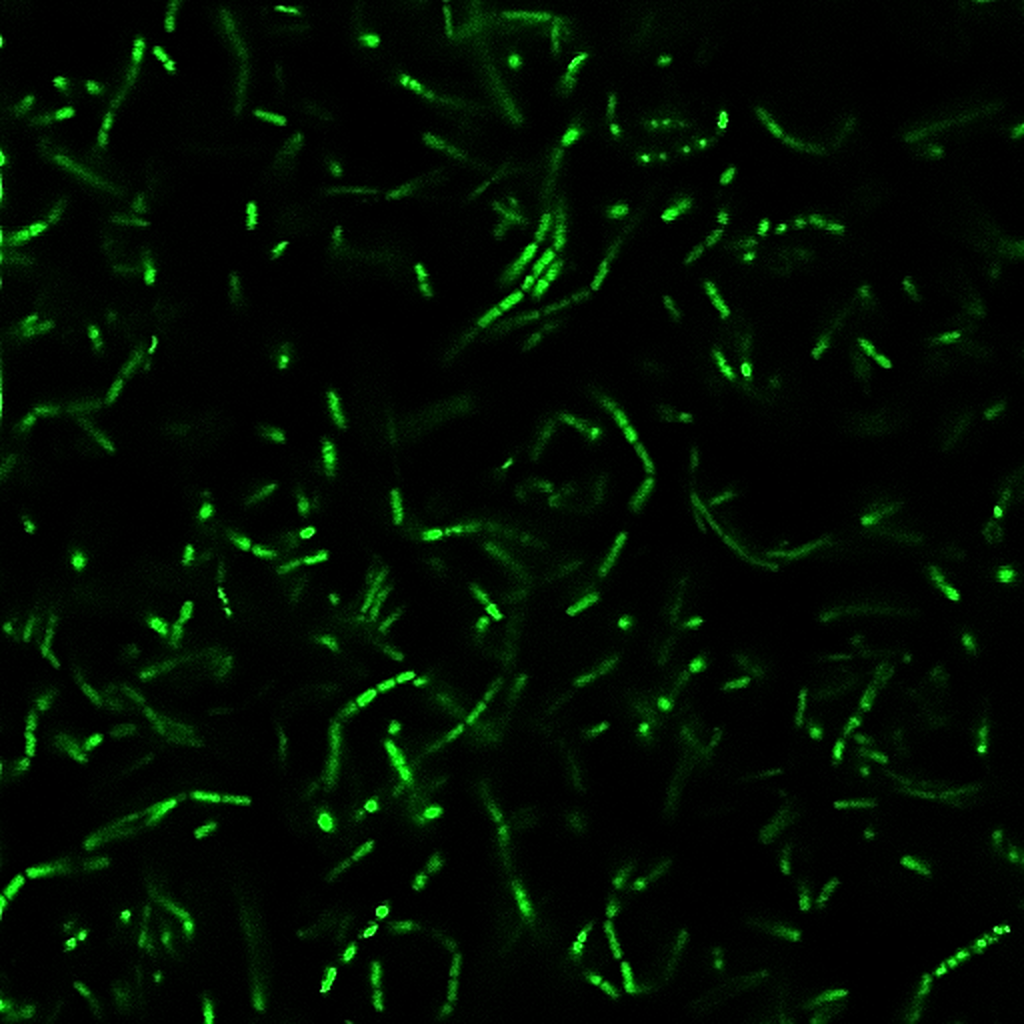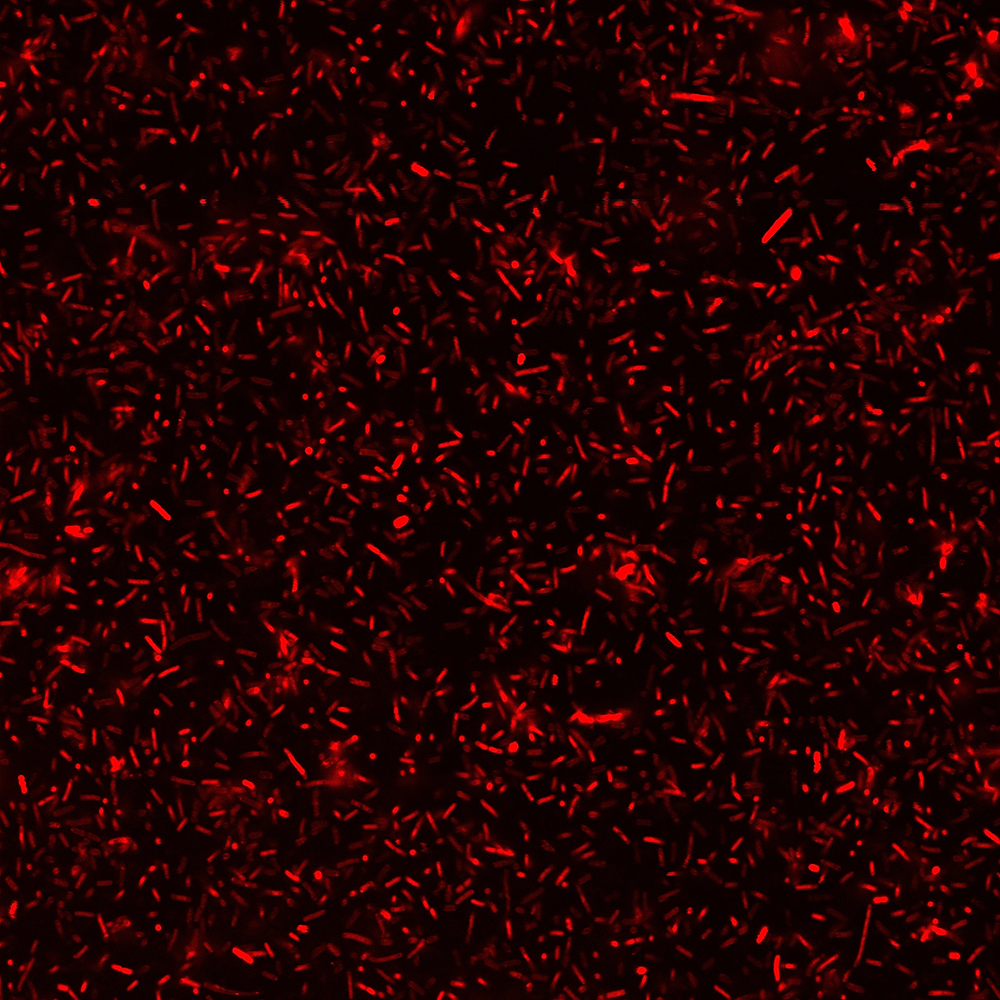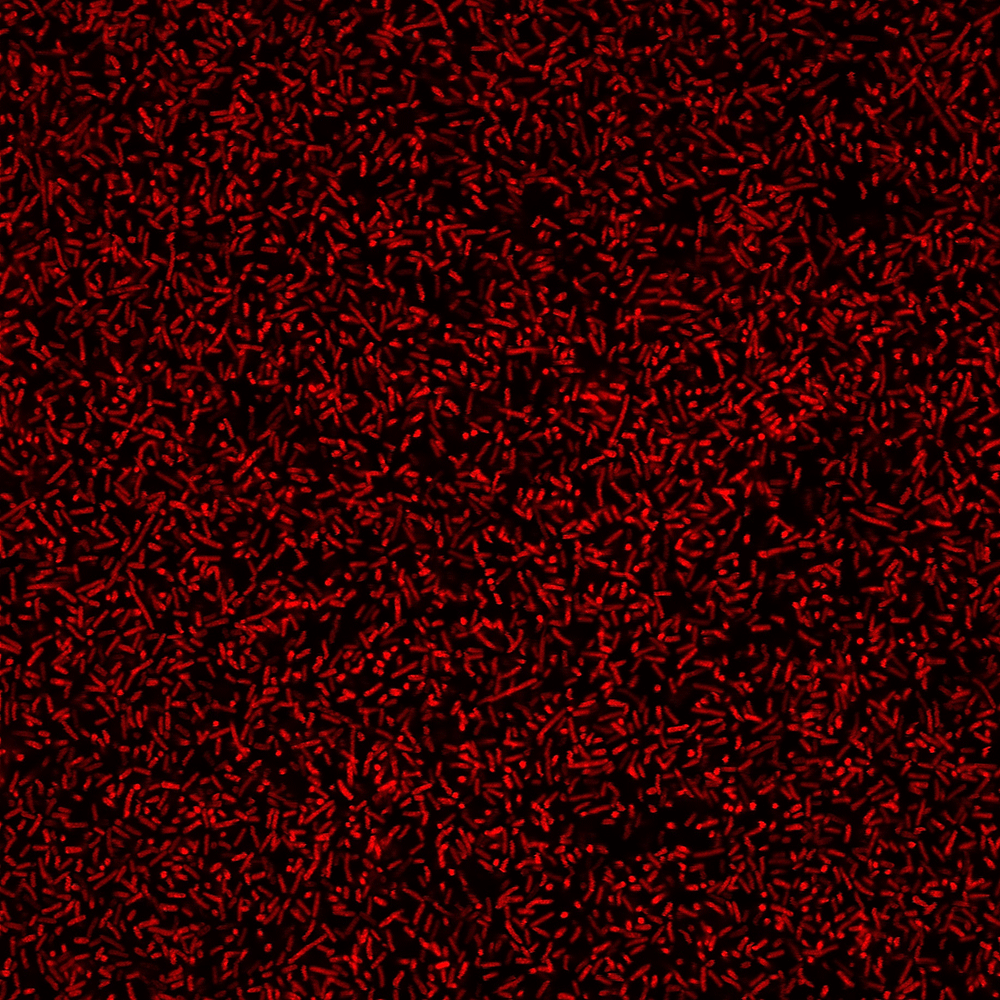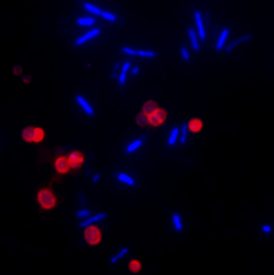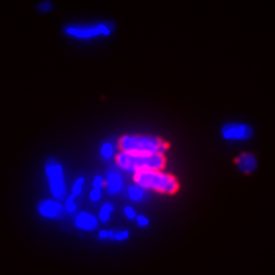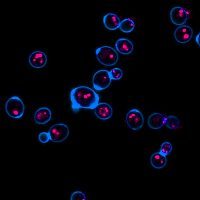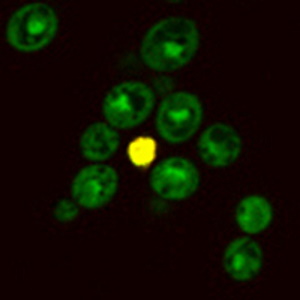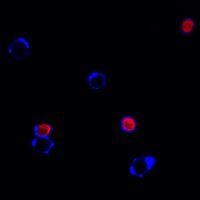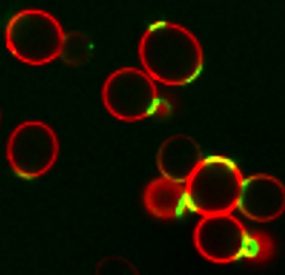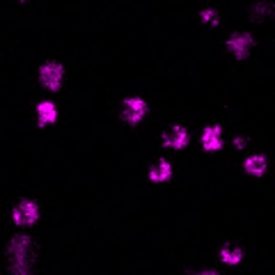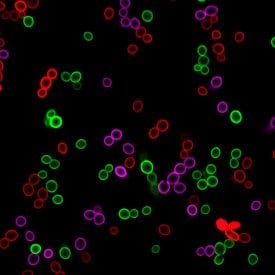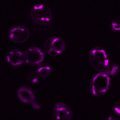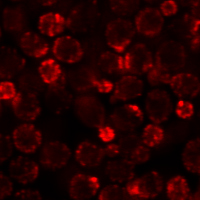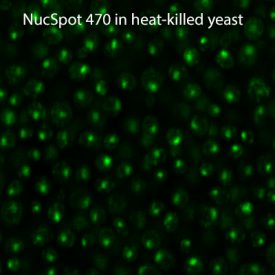At Biotium, our specialty is creating fluorescent dyes that simplify and improve your scientific experiments. For Microbiology, we offer a wide range of fluorescent dyes and assays kits to stain bacteria, yeast and fungi, including dyes to assess cell viability and bacterial gram stain type. We have also developed a complete toolkit of reagents for viability PCR, a revolutionary method for determining microbial viability using qPCR.
Also visit our Cellular Stains Table for a comprehensive list of cellular stains with their ability to stain various cell types.
BACTERIAL VIABILITY STAINS
BactoView™ Dead Stains
BactoView™ Dead Stains are unique DNA binding dyes designed for highly-selective dead cell staining for microscopy or flow cytometry analysis. Unlike traditional vital nucleic acid dyes like propidium iodide or ethidium homodimer that are excluded from gram-negative bacteria but are taken up by live gram-positive bacteria, BactoView™ Dead Stains are excluded from both gram-positive and gram-negative strains for highly selective live/dead discrimination.
- Highly Selective: Bright staining of dead cells with minimal background
- Compatible: Works with gram-positive and gram-negative strains
- Easy: Requires a single 30-minute staining step, no wash required
- Color Choice: Available in 7 colors from green to near-IR
BactoView™ Viability Kits
BactoView™ Viability Kits are designed for convenient two-color staining of both live and dead bacteria. Each kit contains a BactoView™ Dead Stain for staining dead cells, and a BactoView™ Viability Green Counterstain for labeling both live and dead bacteria with green fluorescence. The kits are compatible with both gram-positive or gram-negative bacteria strains and are available with a red or far-red BactoView™ Dead Stain.
- Two-Color Staining: Labels both live and dead bacteria
- Compatible: Works with gram-positive and gram-negative strains
- Easy: Requires a single 30-minute staining step, no wash required
- Two Kit Options: Choose from either a red or far-red BactoView™ Dead Stain
BactoView™ Dead Stains Offer Improved Dead Cell Selectivity for Gram-Positive Bacteria
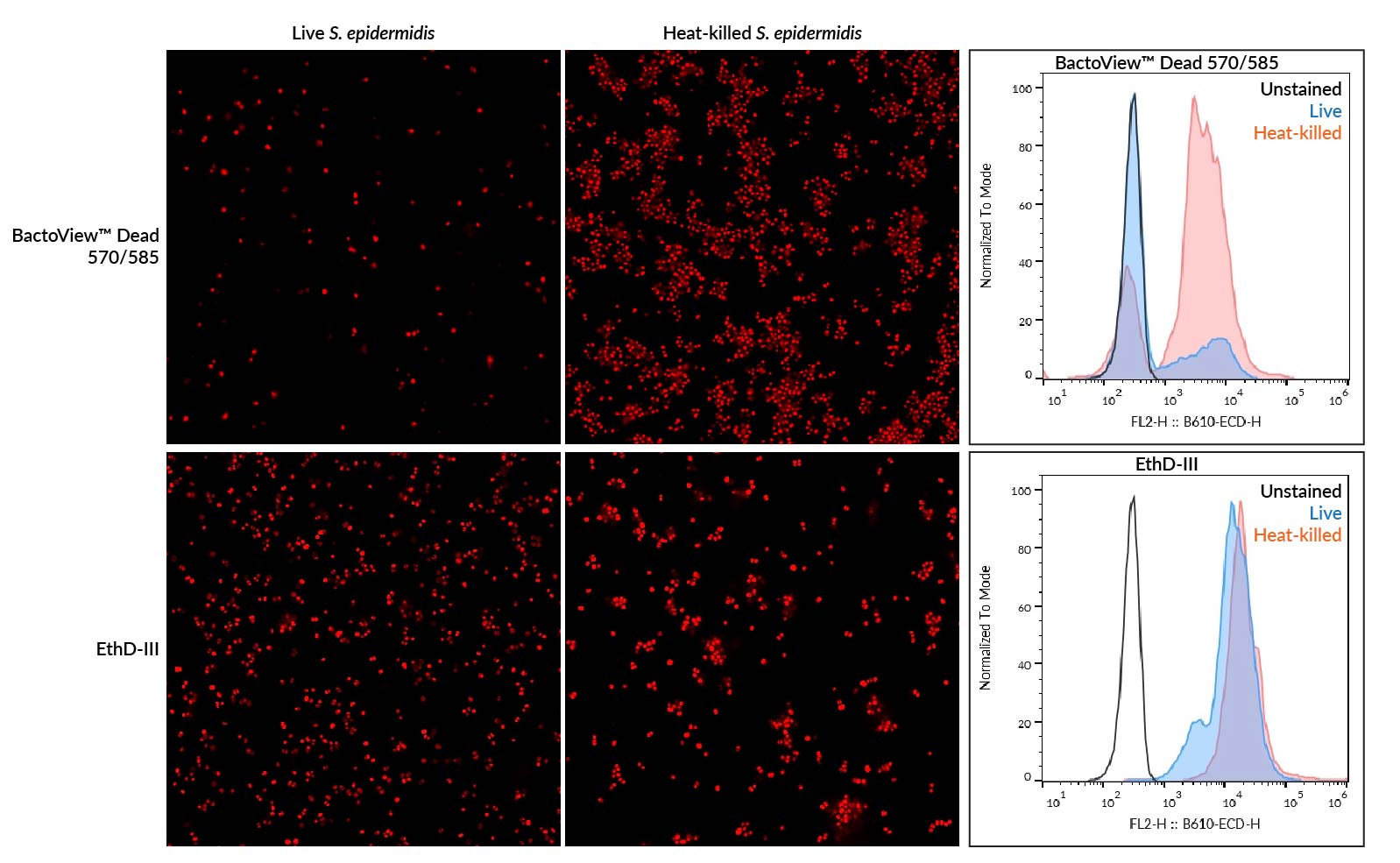
Obtain Robust Visualization of Live & Dead Cells with BactoView™ Viability Kits
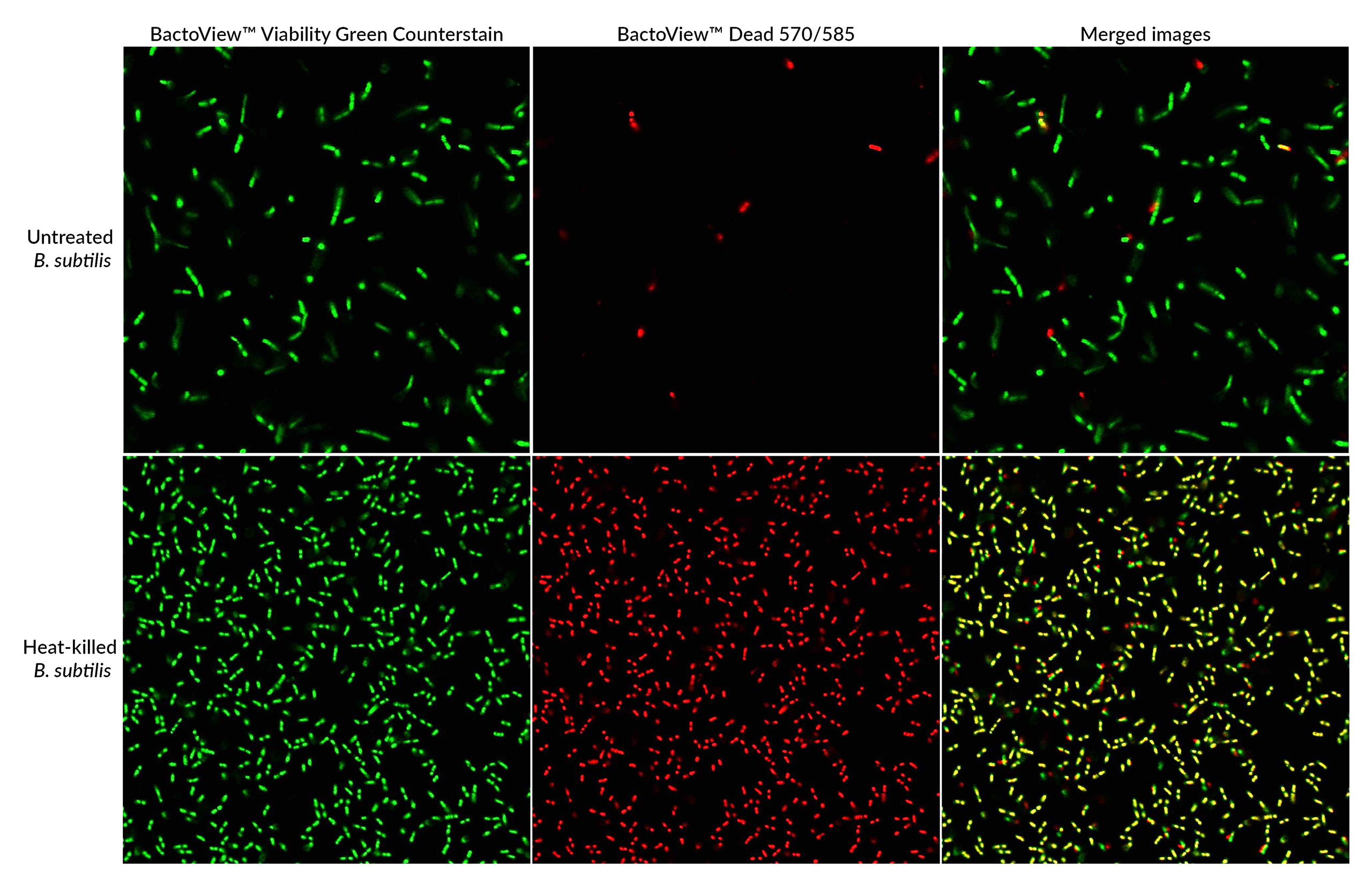
BactoView™ Dead Stains & Viability Kits
| Product Name | Ex/Em (nm) | Detection Channel | Size (1000X in DMSO) | Catalog No. |
|---|---|---|---|---|
| BactoView™ Dead 500/515 | 497/515 | FITC | 20 uL | 40107-T |
| 100 uL | 40107 | |||
| BactoView™ Dead 560/570 | 559/570 | Rhodamine, PI, PE | 20 uL | 40108-T |
| 100 uL | 40108 | |||
| BactoView™ Dead 570/585 | 572/583 | Rhodamine, PI, PE | 20 uL | 40109-T |
| 100 uL | 40109 | |||
| BactoView™ Dead 600/615 | 603/613 | Texas Red® or PE-Texas Red® | 20 uL | 40110-T |
| 100 uL | 40110 | |||
| BactoView™ Dead 655/670 | 653/671 | Cy®5, APC | 20 uL | 40111-T |
| 100 uL | 40111 | |||
| BactoView™ Dead 690/710 | 683/707 | Cy®5.5 | 20 uL | 40112-T |
| 100 uL | 40112 | |||
| BactoView™ Dead 760/780 | 759/780 | Cy®7, APC-Cy®7 | 20 uL | 40113-T |
| 100 uL | 40113 | |||
| BactoView™ Viability Kit (Green/Red) | Green (498/522)/Red (572/583) | FITC (Green)/Rhodamine, PI, PE (Red) | 1 kit | 32019 |
| BactoView™ Viability Kit (Green/Far-Red) | Green (498/522)/Far-Red (653/671) | FITC (Green)/Cy®5, APC (Far-Red) | 1 kit | 32020 |
Other Bacterial Viability Stains & Kits
| Product Name | Features |
|---|---|
| Live-or-Dye™ Fixable Viability Staining Kits | • Fixable dead cell stains • Wide selection of colors • Useful for flow cytometry or microscopy |
| Live-or-Dye NucFix™ Red Staining Kit | • Fixable, DNA-binding dead cell stain • Works in gram-negative bacteria only • Stains dead cells red |
| RedDot™2 Far-Red DNA Dye | • Nuclear-specific dead cell stain • Stains dead cells with far-red fluorescence |
| Viability/Cytotoxicity Assay Kit | • Suitable for gram-negative bacteria only • Green fluorescent DMAO stains DNA in all bacteria • EthD-III stains gram-negative dead cells red |
| Bacterial Viability and Gram Stain Kit | • CF®488A WGA stains gram-positive cells green • EthDIII stains gram-negative dead cells red • DAPI stains alll cells blue |
| 5-Cyano-2,3-ditolyl tetrazolium chloride (CTC) | • Substrate for measuring bacterial respiratory activity • Healthy cells reduce CTC into an insoluble red fluorescent formazan product |
LIVE BACTERIAL STAINS
Bright Staining of All Bacteria in Your Sample
Need to visualize all bacteria in your sample regardless of species or metabolic state? BactoView™ Live stains are unique cell-permeant, fluorogenic DNA-binding dyes designed for bright staining of live and dead, gram-positive and gram-negative bacteria. The dyes are suitable for both microscopy or flow cytometry and are available in green or red fluorescence.
- Fluorescently label all bacteria in your sample
- Stains live and dead, gram-positive and gram-negative cells
- Suitable for microscopy or flow cytometry
- Available in green or red fluorescence
BactoView™ Live Dyes
| Product Name | Ex/Em (nm) (with DNA) | Detection Channel | Size (500X in DMSO) | Catalog No. |
|---|---|---|---|---|
| BactoView™ Live Green | 500/520 | FITC | 20 uL | 40102-T |
| 100 uL | 40102 | |||
| BactoView™ Live Red | 572/675 | Cy®3 (microscopy) PE-Cy®5 (flow cytometry) | 20 uL | 40101-T |
| 100 uL | 40101 |
Optimized Staining of Endospores
BactoSpore™ stains were develop to tackle the challenge of endospore detection by offering bright staining of endospores as well as live and dead gram-positive and gram-negative bacteria. In B. subtilis, the dyes stain both vegetative cells and endospores and have been validated for detection by fluorescence microscopy and flow cytometry.
- Optimized for staining endospores, unlike other bacterial detection reagents
- Validated for microscopy or flow cytometry
- BactoSpore™ 485/500 for membrane staining in the FITC channel
- BactoSpore™ 488/540 for nucleic acid staining in the FITC or PE channel
BactoSpore™ 485/500 Membrane Stain
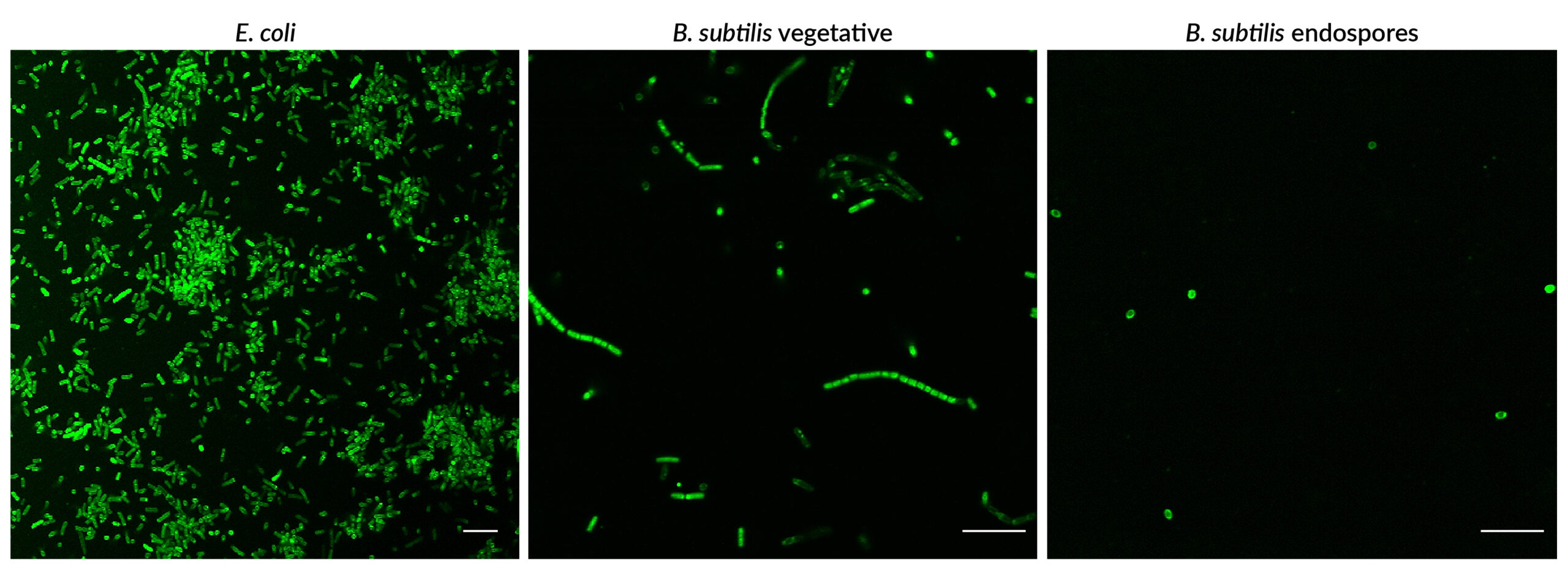
BactoSpore™ 488/540 Nucleic Acid Stain
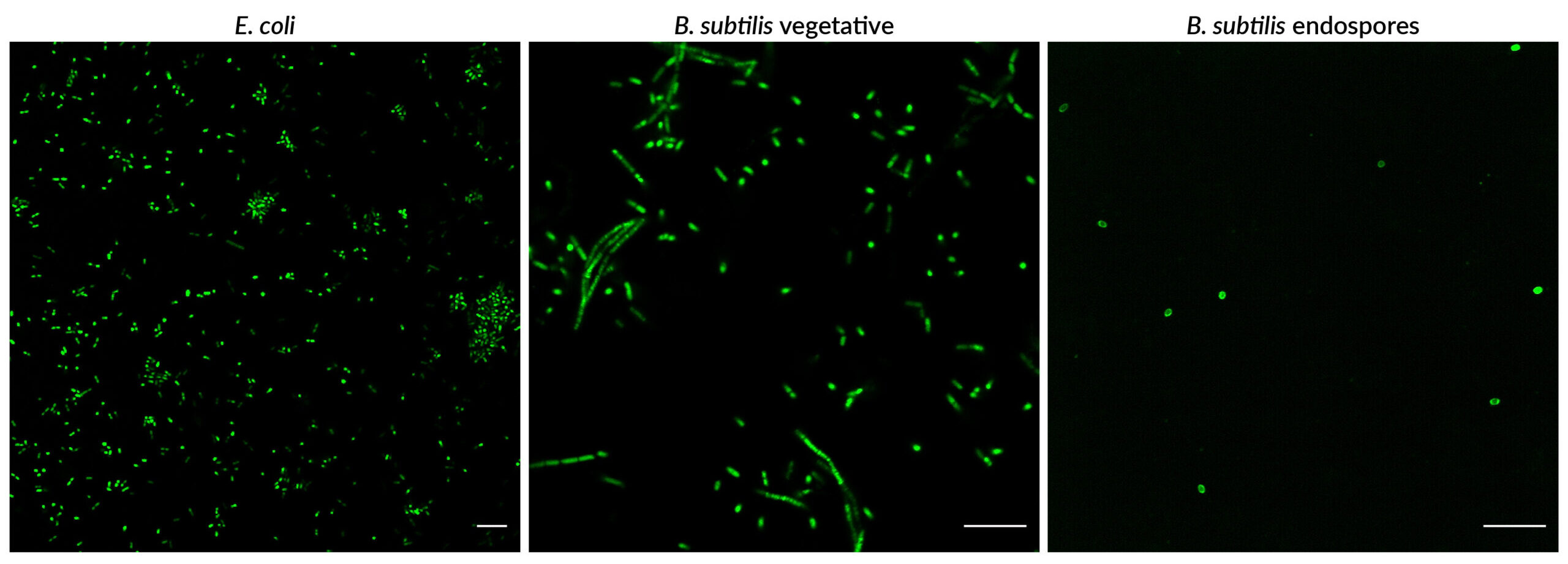
BactoSpore™ Bacterial Stains
| Product Name | Ex/Em (nm) | Detection Channel | Size | Catalog No. |
|---|---|---|---|---|
| BactoSpore™ 485/500 Membrane Stain, 500X in EtOH | 484/504 | FITC | 20 uL | 40119-T |
| 100 uL | 40119 | |||
| BactoSpore™ 488/540 Nucleic Acid Stain, 500X in DMSO | 488/536 (with DNA) | FITC or PE Channel | 20 uL | 40120-T |
| 100 uL | 40120 |
Other Available Dyes for Staining All Bacteria
Product Name | Features |
|---|---|
| RedDot™1 Far-Red DNA Dye | • Nucleic acid binding dye • Far-red fluorescence • Useful for fluorescence microscopy |
| DMAO, 2 mM in DMSO | • Green nucleic acid binding dye • Useful for fluorescence microscopy or flow cytometry |
| Hoechst 33342, 10 mg/mL in H2O | • Blue nucleic acid binding dye • Useful for fluorescence microscopy or flow cytometry |
| Thiazole Orange | • Nucleic acid binding dye • Green fluorescence • Useful for fluorescence microscopy or flow cytometry |
| CellBrite® Fix Membrane Stains | • Fixable membrane dyes • Green, red and far-red options • Useful for fluorescence microscopy |
| SynaptoGreen™ C4 | • Green fluorescent membrane dye • Useful for fluorescence microscopy |
| SynaptoRed™ C2 | • Red fluorescent membrane dye • Useful for fluorescence microscopy |
BACTERIAL GRAM STAINS
A traditional colorimetric gram staining protocol is laborious, requiring up to 5 different solutions to stain cells, including toxic alcohol and acetone to decolorize the sample, and precise timing. In contrast, Wheat Germ Agglutinin (WGA) has been shown to bind specifically to N-acetylglucosamine in the peptidoglycan layer of the cell wall of gram-positive bacteria, and can be labeled with a number of different fluorescent dyes for one-step fluorescent cell labeling. Our WGA conjugates feature bright and photostable CF® Dyes for rapid and sensitive staining of gram-positive bacteria. The WGA conjugates are available in 13 color options as well as combination kits that include counterstains for viability analysis or all bacteria.
| Product Name | Features |
|---|---|
| Wheat Germ Agglutinin (WGA) CF® Dye conjugates | • Fast and sensitive gram stains • Available in 13 colors |
| Live Bacterial Gram Stain Kit | • CF®594 WGA stains gram-positive cells red • DAPI stains all cells blue |
| Bacterial Viability and Gram Stain Kit | • CF®488A WGA stains gram-positive cells green • EthD-III stains dead cells red • DAPI stains all cells blue |
YEAST VIABILITY STAINS
Browse our selection of fluorescent dyes and kits validated for yeast viability analysis cells, including dyes for live/dead discrimination, combination staining kits, and organelle stains. Also learn about Viability PCR for rapid and sensitive assessment of viable yeast by qPCR.
| Product Name | Features |
|---|---|
| Live-or-Dye™ Fixable Viability Staining Kits | • Fixable dead cell stains • Choice of 8 fluorescent colors |
| Propidium Iodide | • Red dead cell stain • Not fixable |
| Ethidium Homodimer III (EthD-III) | • Far-red dead cell stain • Not fixable |
| RedDot™2 Far-Red Nuclear Stain | • Far-red, nuclear dead cell stain • Not fixable |
| NucSpot® 470 | • Green, nuclear dead cell stain • Not fixable |
| ViaVac™ Red/Green | • Yeast-specific vitality dye • stains the vacuole red in metabolically active cells |
| Yeast Live-or-Dye™ Fixable Live/Dead Staining Kit | • Thiazole Orange stains all cells green • Live-or-Dye™ 568/583 stains dead cells red • Fixable staining |
| Yeast Viability Staining Kit | • CF® Dye-labeled Concanavalin A (ConA) to label the cell walls of all cells • Live-or-Dye™ viability dye to label dead cells • Choose blue/green, green/red, or red/far-red color combinations |
| Yeast Vitality Staining Kit | • Calcofluor White labels all cell walls blue • ViaVac™ Red/Green stains the vacuole red in metabolically active cells |
YEAST ORGANELLE STAINS
A number of our organelle and cellular stains can be used to stain yeast cells. Browse our selection of stains below validated for labeling yeast vacuoles, cell walls, bud scars, cytoplasm, and more.
| Product Name | Features |
|---|---|
| MitoView™ Dyes | • Mitochondrial dyes in five colors: • MitoView™ 633 is mitochondrial membrane potential-dependent |
| LysoView™ 540 & 633 | • Label vacuoles in live yeast cells • 2 LysoView dyes stain the yeast vacuole LysoView™ 540 & LysoView™ 633 |
| LipidSpot™ 488 | • Label vacuoles in live yeast cells • Stains intracellular membrane structures |
| Calcofluor White | • Blue fluorescent chitin stain stains cell walls • Strongly stains bud scars |
| CellBrite™ Fix | • Stains the cell membrane • Available in 3 dye colors • Staining is fixable |
| MemBrite™ Fix | • Stains the cell periphery • Available in 8 dye colors • Staining is fixable |
| CF® Dye Concanavalin A (Con A) Conjugates | • Con A lectin binds to a-mannopyranosyl and a-glucopyranosy in the cell wall of yeast and fungi • Available in 10 colors |
| CF® Dye Wheat Germ Agglutinin (WGA) Conjugates | • WGA lectin binds sialic acid and N-acetylglucosamine • Strongly labels bud scars • Available in 13 colors |
| Thiazole Orange | • Green nucleic acid binding dye • Can be used as an all-cell yeast stain • Staining in yeast is both nuclear and cytoplasmic in unfixed cells and cytoplasmic after fixation |
| NucSpot® 470 Nuclear Stain | • Green nucleic acid binding dye • Stains the nucleus of dead or fixed and permeabilized yeast |
| ViaFluor® CFSE | • Can be used as an all-cell cytoplasmic stain in yeast |
| Phalloidin conjugates | • Phalloidin stains F-actin cables and patches in fixed and permeabilized yeast • Available in 20 colors and biotin |
VIABILITY PCR WITH PMA & PMAXX™
Biotium is the inventor of the original viability PCR dye, PMA, and the new and improved viability PCR dye PMAxx™. We have also developed a large range of products and kits for viability PCR. To learn more about this technology and all of the associated products, please visit the Viability PCR Technology Page.
Introduction to viability PCR (v-PCR)
Viability PCR is a powerful technology for the sensitive and rapid detection of viable microorganisms. Unlike time-consuming culturing methods, qPCR is a fast and sensitive method of detection. However, normal qPCR does not distinguish between live and dead cells. With v-PCR using PMAxx™ or PMA, you get the speed, sensitivity and specificity of PCR, plus quantifiable viability. And because no culturing is required, you can even detect viable but not culturable (VBNC) bacteria.The v-PCR technology can be applied not only to bacteria but to other organisms like yeast, viruses, eukaryotes, and archaea.
How does v-PCR work?
The infographic below shows the basic mechanism of v-PCR. PMAxx™ and PMA are photoreactive dyes with high affinity for DNA. The dyes intercalate into dsDNA and form a covalent linkage upon exposure to intense visible light. The reaction inhibits PCR amplification of modified DNA templates by a combination of removal of modified DNA during purification and inhibition of template amplification by DNA polymerases. Because the dyes are cell membrane-impermeable, when a sample containing both live and dead bacteria is treated with dye, only dead bacteria with compromised cell membranes are susceptible to DNA modification. In a qPCR reaction, dead cell DNA will show delayed amplification and higher Ct than live cells.

PMA & PMAxx™ Dyes for Viability PCR
PMA is the original dye developed at Biotium for v-PCR. It has been validated in a wide variety of bacterial strains, as well as yeast and viruses (see PMA References). However, while PMA is generally effective at differentiating between live and dead bacteria by qPCR, it does not completely eliminate PCR products from dead cell DNA. This could potentially give false positive results.
PMAxx™ was designed by Biotium scientists to be a superior alternative to PMA. PMAxx™ is much more effective at eliminating PCR amplification of dead cell DNA, and therefore provides the best discrimination between live and dead bacteria.
Download the PMA™ and PMAxx™ flyer to learn more.
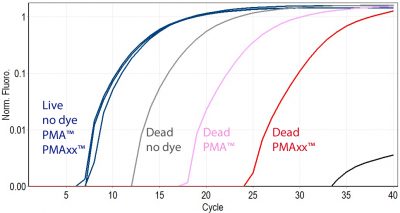
| Product Name | Catalog No. | Features |
|---|---|---|
| PMAxx™, 20 mM in H2O | 40069 | • Next-generation v-PCR dye • Gives the best live/dead discrimination |
| PMA Dye | 40013 | • Original v-PCR dye developed at Biotium • Validated in hundreds of publications and a wide variety of organisms |
| PMA Dye, 20 mM in H2O | 40019 |
Other Viability PCR Reagents
Viability PCR Starter Kits
The customizable Viability PCR Starter Kits contain the materials that you need for selective detection of viable cells using either PMA or PMAxx™ viability dye and qPCR. You also have the choice of selecting a kit with or without the Enhancer for Gram Negative Bacteria (not to be used with other cell types). The user will need to supply their own primers to amplify their species of interest .
| Product Name | Catalog No. | Viability Dye | Target Cell Type |
|---|---|---|---|
| Viability PCR Starter Kit with PMA | 31075 | PMA | Any cells |
| Viability PCR Starter Kit with PMAxx™ | 31075-X | PMAxx™ | Any cells |
| Viability PCR Starter Kit with PMA and Enhancer | 31076 | PMA | Gram-negative bacteria |
| Viability PCR Starter Kit with PMAxx™ and Enhancer | 31076-X | PMAxx™ | Gram-negative bacteria |
Strain-Specific Viability PCR Kits
Strain-specific v-PCR kits are designed for selective detection of viable bacteria from a specific strain using PMAxx or PMA dye and real-time PCR. The kits contain PMA dye OR PMAxx™ dye, Forget-Me-Not™ EvaGreen® qPCR Master Mix, and validated PCR primers for detection of selected strains of bacteria.
Strain-Specific Bacterial Viability PCR Kits
| Bacteria Strain | Gene name | Kit with PMA (catalog #) | Kit with PMAxx™ (catalog #) |
|---|---|---|---|
| Salmonella enterica | invA | 31033 | 31033-X |
| Mycobacterium tuberculosis | groEL2 | 31034 | N/A |
| Staphylococcus aureus | nuc | 31035 | N/A |
| MRSA | mecA | 31036 | N/A |
| E. coli O157:H7 | Z3276 | 31037 | 31037-X |
| E. coli | uidA | 31050 | 31050-X |
| Listeria monocytogenes | hly | 31051 | 31051-X |
| Legionella pneumophila | mip | 31053 | N/A |
PMA Enhancer for Gram-Negative Bacteria
PMA Enhancer for Gram Negative Bacteria was designed to improve discrimination between live and dead gram-negative bacteria during viability PCR. PMA Enhancer is provided as a 5X solution, and is added to a sample before the addition of viability dye.
| Product Name | Catalog No. | Features |
|---|---|---|
| PMA Enhancer for Gram Negative Bacteria, 5X Solution | 31038 | • Improves live/dead discrimination in gram-negative strains |
Photoactivation Device
The PMA-Lite™ 2.0 LED Photolysis Device allows for time- and temperature-controlled light treatment of PMAxx- or PMA-treated samples in microcentrifuge tubes.
| Product Name | Catalog No. | Features |
|---|---|---|
| PMA-Lite™ 2.0 LED Photolysis Device | E90006 | • Photoactivation device, holds 18 microcentrifuge tubes |
Associated products
Bacterial Viability and Gram Stain Kit
Concanavalin A (Con A) CF® Dye Conjugates
29136, 29015, 29016, 29017, 29018, 29019, 29020, 29058, 29074, 29075, - 29080View allHide
PMAxx™ Dye, 20 mM in H2O
40069-1ML, - 40069View allHide
Viability/Cytotoxicity Assay Kit for Bacteria Live & Dead Cells
Yeast Live-or-Dye™ Fixable Live/Dead Staining Kit
Yeast Vitality Staining Kit
Wheat Germ Agglutinin (WGA) Conjugates
29128-1, 29128, 29095-1, 29095, 29021, 29022, 29023, 29024, 29025, 29026, 29027, 29028, 29029, 29059, 29064, 29073, 29021-1, 29022-1, 29023-1, 29024-1, 29025-1, 29026-1, 29027-1, 29028-1, 29029-1, 29059-1, 29064-1, 29077-1, 29077, 29076-1, - 29076View allHide
Live Bacterial Gram Stain Kit
32000, - 32000-1View allHide

